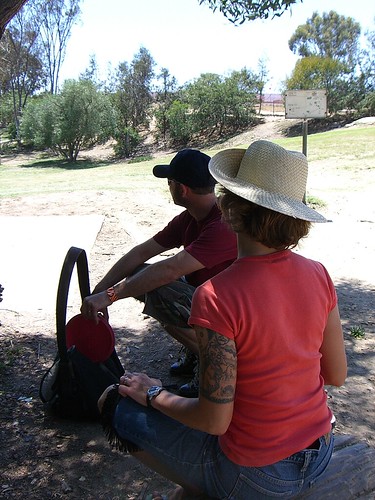Fast Fitness - Contest: What Does It Take To Sit Upright?
Friday, October 16, 2009
Jolie Bookspan, M.Ed, PhD, FAWM
Conventional beliefs about posture include that you must do certain exercises or stretches or strengthening to change your posture. Is that true?
Look at photo 1 and 2 and answer the simple question below:
Photo 1

photo 2

Submit Your Answer:
- What muscle strengthening or stretch is required to change from first (unhealthy rounded) to second (upright) sitting?
- Name the muscle(s) and action needed - don't just name a muscle, say which way it needs to pull.
- Explain why the same people (with the same tightness or weakness) who sit with the lower spine rounded forward (flexion) often stand with the lower back overly curved inward (hyperlordosis) - just the opposite.
Use your brain. Partial credit applies. I will post answers, explanations, and winners.
Hint for success:
- Sit and try it yourself, don't go only to anatomy books.
- Fixing Posture - No Exercise Needed
- Upper Body Built in Functional Fitness
- Tax Preparation Health
- Back to School - Healthy Sitting
- Are You Making Your Exercise Unhealthy?
- Household Fitness in the New Year
- The Story of the Black Belt
- Don't Fall for "Don't Sit Up Straight"
- Sitting Badly Isn't Magically Healthy by Calling It a Hamstring Stretch
- Does an Exercise Ball Make You Sit Straight?
Random Unrelated Fitness Fixer (or is it?):
---
Read inspiring success stories of these methods and send your own. See if your answers are already here by clicking post labels, links, archives at right, and Index. For answers to personal medical questions - Replies to Medical Questions.
Subscribe free, "updates via e-mail" upper right.
Limited Class space for personal feedback. Top students may earn certification, DrBookspan.com/Academy.
Learn more (answer to this quiz too) in Dr. Bookspan's Books.
Subscribe free, "updates via e-mail" upper right.
Limited Class space for personal feedback. Top students may earn certification, DrBookspan.com/Academy.
Learn more (answer to this quiz too) in Dr. Bookspan's Books.
Labels: contest, education, fast fitness, fix pain, International Academy of Functional Sports Medicine, mind, posture, sitting

4 Comments:
At Friday, October 16, 2009 9:09:00 AM, Anonymous said…
Anonymous said…
1. The pectoral stretch will help lengthen the chest muscles to make sitting up easier, but the muscle required to change from rounded to upright is the brain.
2. A combination of abs and brain are required to think and correct bad posture. The abs are used to hold the hip in the correct position to maintain a small curve in the lower back.
3. Flexion and hyperlordosis are a result of improper use of the ab muscles and a shortage of understanding the definition and benefits of good posture.
Paul J.
At Saturday, October 17, 2009 12:01:00 PM, Anonymous said…
Anonymous said…
The transversus abdominis and middle trapezius need to be engaged, and the pectorals need to be stretched.
But contrary to your instructions, the legs can't be ignored. Overtight hip flexors often prevent people from moving their pelvis into neutral.
Dana
At Friday, December 04, 2009 2:38:00 PM, bikabill said…
bikabill said…
1. Only the brain is required. I simply have to do it!
2. Name the muscles -- lean back by stretching the pectorals, and maintain neutral spine in the lower back by contracting the abdominal muscles. All these years I was just too ignorant to use them until Dr. Jolie said so!
3. I think it's 'cause their chest is too tight from rounded shoulders. Good pectoral stretching, and remembering to maintain good posture wil correct.
It's that remembering thing that's the problem. Fortunately my back keeps reminding my brain to use what I've learned! :-D
At Monday, December 07, 2009 7:13:00 AM, bikabill said…
bikabill said…
In my case I have to straighten the upper back by extending the upper abs and maintain neutral position in the lower back by contracting the lower abs. It's a continuous workout throughout the day but I only get sore if I don't do it.
Post a Comment
<< Home